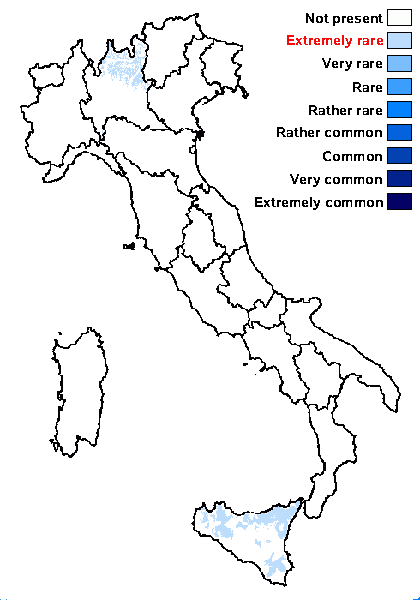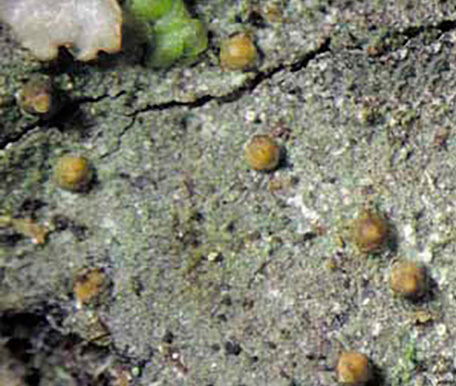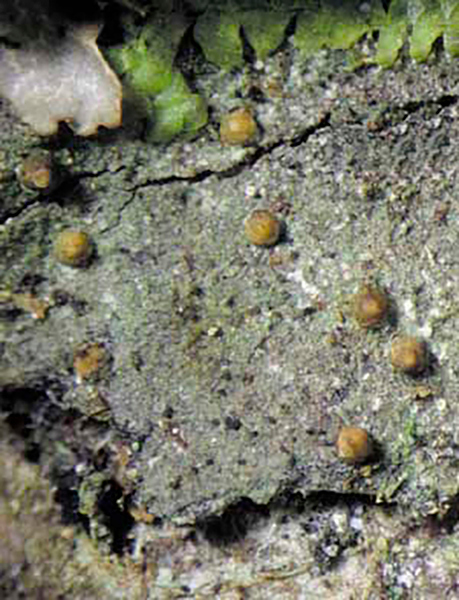Thelopsis flaveola Arnold
Verh. zool.-bot. Ges. Wien, 23: 505, 1873.
Synonyms:
Distribution: N - Lomb (UPS- L-166842). S - Cal (Ravera & al. 2025), Si (Nimis & al. 1994).
Description: Thallus crustose, thinly episubstratic, usually continuous, grey-green turning grey-white in the herbarium, sometimes poorly evident. Perithecia yellowish, 0.2-0.3 mm wide, completely to half immersed in the thallus, the ostiole often poorly visible. Exciple c. 30 μm thick, of intertwined hyphae with thick gelatinized walls, the innermost layer of thin-walled hyphae, colourless or brownish in upper part; periphyses septate, well developed in the periostiolar region, up to 20 μm long, c. 2 μm thick, with somehow pointed apical cells; paraphyses clearly septate, 170-230 μm long, 1.5-2 μm thick at base, c. 1 μm thick in upper part; hymenial gel I-. Asci up to 300-spored, cylindrical, tapering towards the apex, the wall thin, 1+ light blue, without a tholus. Ascospores 1-celled, hyaline, ellipsoid to ovoid, 4-6 x 3-4 μm, often with a large oil drop in the centre, surrounded by a thin gelatinous perispore. Photobiont trentepohlioid. Spot tests: K-, C-, KC-, P-, UV-. Chemistry: without lichen substances.Note: a mainly temperate species found on bark of ancient deciduous trees, but also, in the subalpine belt, on bases of old Rhododendron shrubs; to be looked for further in the Alps. It is included as “Critically Endangered” in the Italian red list of epiphytic lichens (Nascimbene & al. 2013c).
Growth form: Crustose
Substrata: bark
Photobiont: Trentepohlia
Reproductive strategy: mainly sexual
In underhangs rarely wetted by rain
Commonnes-rarity: (info)
Alpine belt: absent
Subalpine belt: extremely rare
Oromediterranean belt: absent
Montane belt: extremely rare
Submediterranean belt: absent
Padanian area: absent
Humid submediterranean belt: extremely rare
Humid mediterranean belt: absent
Dry mediterranean belt: absent

Predictive model
Herbarium samples
Growth form: Crustose
Substrata: bark
Photobiont: Trentepohlia
Reproductive strategy: mainly sexual
In underhangs rarely wetted by rain
Commonnes-rarity: (info)
Alpine belt: absent
Subalpine belt: extremely rare
Oromediterranean belt: absent
Montane belt: extremely rare
Submediterranean belt: absent
Padanian area: absent
Humid submediterranean belt: extremely rare
Humid mediterranean belt: absent
Dry mediterranean belt: absent

Predictive model
| Herbarium samples |
 INDEX FUNGORUM
INDEX FUNGORUM
 GBIF
GBIF
 DOLICHENS
DOLICHENS



